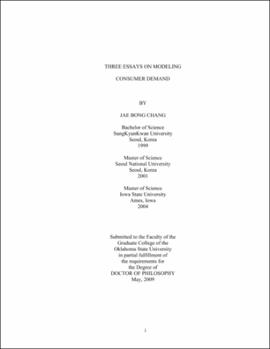| dc.contributor.advisor | Lusk, Jayson L. | |
| dc.contributor.author | Chang, Jae Bong | |
| dc.date.accessioned | 2013-11-26T08:21:59Z | |
| dc.date.available | 2013-11-26T08:21:59Z | |
| dc.date.issued | 2009-05 | |
| dc.identifier.uri | https://hdl.handle.net/11244/6509 | |
| dc.description.abstract | Scope, Method of Study, and Findings: Although stated preference data obtained through real and hypothetical surveys and experiments are increasingly being used in economic research, there remain doubts about the validity of preference elicitation methods and econometric models used to estimate consumer preferences. This study explores such doubts and provides richer understanding of consumer demand. | |
| dc.description.abstract | The first essay compared the ability of three preference elicitation methods (hypothetical choices, non-hypothetical choices, and non-hypothetical rankings) and three discrete-choice econometric models (the multinomial logit [MNL], the independent availability logit [IAL], and the random parameter logit [RPL]) to predict actual retail shopping behavior in three different product categories (ground beef, wheat flour, and dishwashing liquid). Overall, this study found a high level of external validity. Specific results suggested that the non-hypothetical elicitation approaches, especially the non-hypothetical ranking method, outperformed the hypothetical choice experiment in predicting retail sales. This study also found that the RPL can have superior predictive performance, but that the MNL predict equally well in some circumstances. | |
| dc.description.abstract | Although experimental studies have reported a wide array of other-regarding behavior, the pervasiveness of such behavior in the field is an open question. Using a stated preference experiment, the second essay first estimated people's preferences, when purchasing food products, for the distribution of benefits accruing to participants in the food supply chain. Although none of the existing fairness models exhibit much predictive power, this study found that people are in-fact concerned about the distribution of benefits resulting from food purchases, and that modifications to the models to fit the food context significantly improves explanatory power. Finally, this study found that the measured preferences, along with elicited beliefs are significant predictors of people's willingness-to-pay a premium for organic food. | |
| dc.description.abstract | RPL or mixed logit models are increasingly being reported in the literature, but uncertainties about the reliability of the model remain. Using Monte Carlo simulations, the third paper found that mixed logit estimates exhibit bias in small samples (N=200); an effect that dissipates as sample size increases. Despite the fact that the conventional multinomial logit is a restricted form of the mixed logit, simulation results indicate that if there is no preference heterogeneity, the conventional multinomial logit provides much more efficient estimates than the mixed logit. Moreover, in large samples there is a high likelihood of observing type I errors - finding statistically significant heterogeneity when none exists. Finally, simulation results indicate differences in performance across commercial software package providing mixed logit estimation routines. | |
| dc.format | application/pdf | |
| dc.language | en_US | |
| dc.rights | Copyright is held by the author who has granted the Oklahoma State University Library the non-exclusive right to share this material in its institutional repository. Contact Digital Library Services at lib-dls@okstate.edu or 405-744-9161 for the permission policy on the use, reproduction or distribution of this material. | |
| dc.title | Three essays on modeling consumer demand | |
| dc.contributor.committeeMember | Brorsen, Wade B. | |
| dc.contributor.committeeMember | Norwood, F. Bailey | |
| dc.contributor.committeeMember | Adkins, Lee C. | |
| osu.filename | CHANG_okstate_0664D_10300 | |
| osu.accesstype | Open Access | |
| dc.type.genre | Dissertation | |
| dc.type.material | Text | |
| thesis.degree.discipline | Agricultural Economics | |
| thesis.degree.grantor | Oklahoma State University | |
